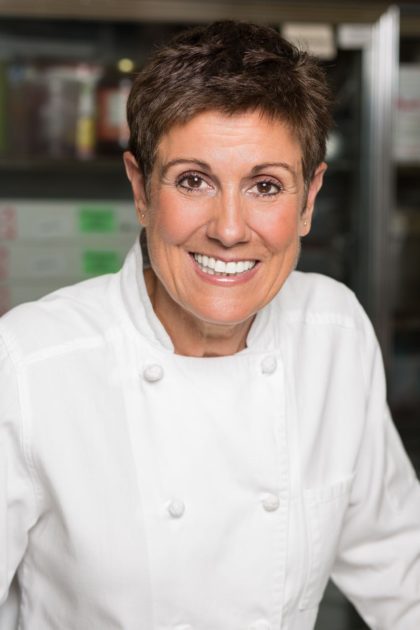 Whether Duane Park Patisserie is baking a $2,500 specialty cake or the 3,000 brownies it gives away for free every Halloween, one thing is certain: “Everything we make has to taste as if it’s the only thing we do, as if we made it specifically for that person,” says Madeline Lanciani, founder of the Tribeca landmark (in business since 1992) and a more recent spin-off, Ring Ding Bar.
Whether Duane Park Patisserie is baking a $2,500 specialty cake or the 3,000 brownies it gives away for free every Halloween, one thing is certain: “Everything we make has to taste as if it’s the only thing we do, as if we made it specifically for that person,” says Madeline Lanciani, founder of the Tribeca landmark (in business since 1992) and a more recent spin-off, Ring Ding Bar.
How did you get started in this business?
My parents were immigrants, and because of their culture, my brothers and sisters and I ate local before it was cool. My mother—a typical stay-at-home mom—made everything herself, including baked goods and bread. Food and meals were a very important part of family life: We had to be home for dinner no matter what. (Not till college did I eat at a friend’s house.) I grew up learning how to cook—all of us did, even the boys. And we all learned stuff like car maintenance, too! It was just practical. As a kid, besides babysitting, I earned money working at local restaurants—as a waiter, busboy, carhop….
Carhop?! Where was this magical place?
Southern Ohio. I was always attracted to the kitchen, so as soon as I could, I got in. But at the same time, I always studied music. My goal was to sing, preferably opera, and to be onstage. I studied keyboard since I was eight years old, and I went to college for music and opera. I used to make money in college singing, but also catering, making food for the receptions for artists who came to the conservatory to perform. This is a digression….
Go for it.
One time, Beverly Sills was coming to do a master class, and I was so excited. The day of the event, I was bringing trays of food to the room, backing my way through the door, when she came the other direction and I literally ran into her with a tray of brownies. I was so flustered. She laughed, took a brownie, and said, “Oh, how delicious!” Fast forward four years later, in New York City. A friend who knew Beverly and I went to see her perform. Afterward, we went backstage to meet her. When we got to the front of the line, she gave my friend a hug, and then she looked at me and said, “You’re the brownie girl!”
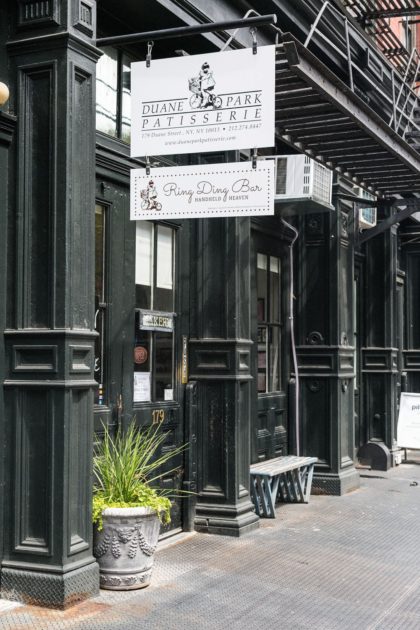 It’s certainly one way to get remembered….
It’s certainly one way to get remembered….
I had my Equity Card by the time I was 17. I did summer stock for five summers: Cabaret with Joel Grey, Mame with Ann Miller. I moved to New York to perform and sing; I performed at the Amato Opera, which is now defunct, and I was in the musical version of a temperance play called The Drunkard. The composer was Barry Manilow! I still have the music somewhere…. But this was the beginning of the rock era, and there wasn’t much work on Broadway. I kept getting road shows, but at some point I just didn’t want to do it anymore. I wanted to be in New York! I got a day job working for an airline, and my night job was baking in my apartment and selling to food stores in the Village. It was very well received. Realizing I could do this for a living, I started looking to get trained. The Culinary Institute of America was still in New Haven at that point, and anyway, it was too expensive. My student loans were coming due and the last thing I needed was more debt. I decided to do it the old-fashioned way and apprentice. I took a night course on baking, aimed at people already in the industry who wanted to advance themselves. The teacher was Konrad Stingl, a master baker from Switzerland who didn’t laugh at me, even though I was the only female in the class. He took me under his wing and gave me his old recipes, some of which I still use to this day. He tried to help me get a job, but no one would hire me because they just didn’t hire women. At the A&P test kitchen in Queens, I was actually told, “We can’t hire you. We don’t have any girls.” That kept happening. They looked at me like I had three heads. Konrad suggested that I try the Plaza Hotel, offering to hang out and just work. That’s what I did. Joe Lanciani, the pastry chef at the time, was a little skeptical at first, but he knew Conrad and he let me hang out. I was quiet as a mouse; I did what I was told. After four months, Joe told the executive chef to hire me. But there was no room in the pastry shop. He asked if I’d be interested in the garde manger, the cold-food department, and I said yes, absolutely, but I still had to wait for a position to open up—so that was another four months working for free.
Finally, I was able to quit my day job, and I was totally hooked. I loved the entire theater of food prep and food service—and theater is what it is. I also got bit by the savory food part. The executive chef developed an apprenticeship for me where I worked three, four, five months in all the stations, for two-and-a-half years. I was the only female—99 men and me—and I wasn’t exactly welcomed with open arms. There were no bathroom facilities; I had to go four flights up to where the housekeepers were. In the performing arts, you only get the job if you can do the job—if you can’t sing, you’re not doing any singing. So my philosophy was: I’m going to make sure I do the job better than it has ever been done, and I’ll earn the respect of the guys who didn’t want me there. I’d say a third didn’t want me there, a third were fine with it, and a third were curious. The first third did things to me that they’d be in jail for now. But I never cried, never broke, never let on that they were hurting me. By the time I left in 1976, they were all in my camp, but it was hard.
In the meantime, I married Joe. We wanted to open our own restaurant—I’d cook, and he’d do pastry. When I started studying how to open a restaurant, however, I discovered that the mortality rate for restaurants was 90%. And for bakeries, it was just 10%. “Forget the restaurant,” I told Joe. “We’re opening a bakery.” So that’s what we did. This was in 1977, on W. 4th Street. We were the Dominique Ansel of our day! People stood out in line to buy a croissant. Back then, if you wanted a croissant, you had to go to Paris. It was fun, and we were successful. We opened another location, right across from Raoul’s on Prince Street, in 1985. Along the way, we got divorced, but stayed business partners. In 1988, we each remarried, and even though Joe and I were fine, each of us having spouses made it too difficult. We split the business: I kept Prince Street, and he kept W. 4th.
[“Do you run Duane Park Patisserie?” asks a young woman on her way out the door. “I’ve been coming here since I was two and now I’m eighteen. I love it!”]
Thank you! I turned the bakery on Prince into a café/restaurant called Madeline’s. We got reviewed by Bryan Miller in the New York Times. He gave us one star, which was great. But the lease kept getting more expensive, and by 1991, it was untenable. We closed in 1991, and I worked for a while from the Raoul’s basement, baking for clients. In 1992, I found this place, and I’ve been here ever since.
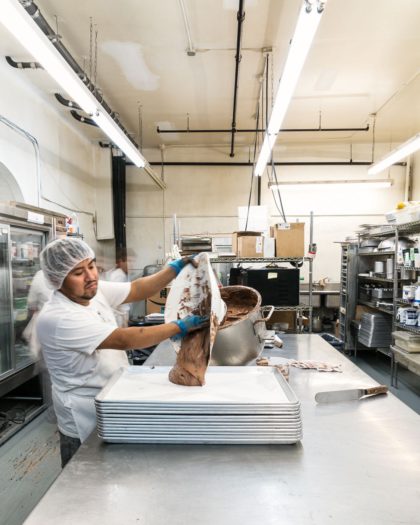 What is Duane Park Patisserie known for?
What is Duane Park Patisserie known for?
Consistency, dependability. We’re an old-fashioned pastry shop, and I’ve resisted the trend to be a specialty store. And I think we’re known for the quality of our ingredients.
What’s the most satisfying part of what you do?
Baking and creating.
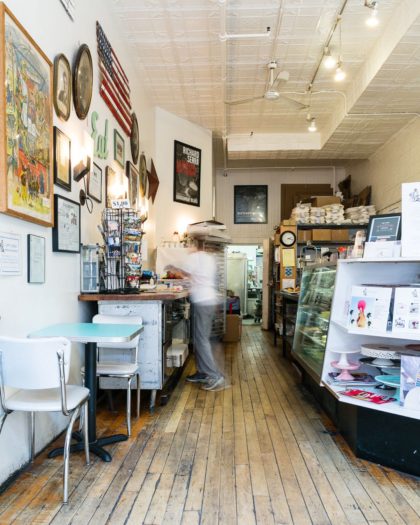 Most popular item?
Most popular item?
The Ring Dings. As a little girl, I wasn’t allowed to have things like Ring Dings. My mother thought they were junk. Instead, we made our own version. The Magic Cupcake we sell is my own version of a Hostess cupcake, which I’ve made since I was a little kid. I actually won the junior division of the Pillsbury Bake-Off with it. As for the Ring Dings, for at least five years I was making them for catering, a mini version for clients who wanted a petit four that wasn’t precious, that was more fun. My millennial son and daughter loved them—they never ate the real things either—and they told me I should sell them in the store. So I made the classic chocolate-and-vanilla version in the store, and they were a hit. My son insisted I add different flavors. That spurred me on, and I’ve been coming up with flavor combos ever since. And then my son said that we should sell them at Smorgasburg, so last year, I applied and auditioned.
Did you sing?
No! But they loved them—and a whole new line of pastries was born. I figured it was a matter of time till whoever owned the Ring Dings trademark would force me to rename them, but when the letter came, it wasn’t a cease-and-desist! They had been here, bought some of my Ring Dings, and loved them. They allowed me to use the name as long as I stay out of their market—supermarket snack cakes—and I post a disclaimer. In fact, when an executive at the company recently retired, they ordered my Ring Dings for the party.
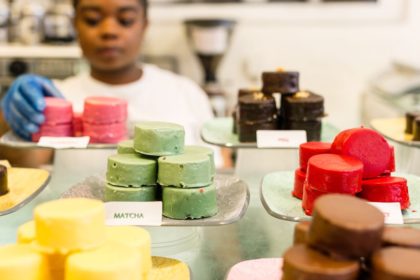 Most expensive item?
Most expensive item?
The specialty cakes that we design for private customers. In February, we made a three-foot-tall scale model of 1 World Trade Center. That was $2,500.
Least expensive item?
One cookie. If you want to buy a single cookie, that’s fine with me! We’ll weigh it and charge you 11¢ or whatever it ends up being.
Your very favorite item right now?
It’s whatever I’m making at the moment. That really is true. Right now, it’s the PB&J Ring Ding. I eat all of the little leftover pieces.
How has your business changed over the years?
When I first opened here, there definitely weren’t as many people. And I didn’t have a retail counter—it was mostly business to caterers. Catering was 70 percent of the business for a long time; it’s probably 60 percent now. Zoning in Tribeca didn’t allow retail on side streets, but I was allowed because it was an accessory use to manufacturing. (This was 20 years ago.) It started as extra pastries left over from catering orders. I put stuff out, and if people liked it, they bought it. More and more people wanted lemon tarts, or whatever, without the selection being hit or miss, so I made a line of pastries for the store.
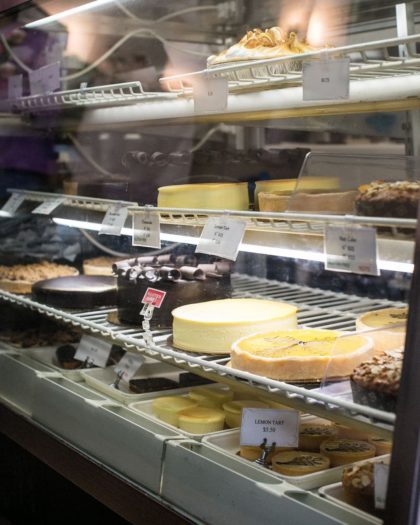 What percentage of your business is local?
What percentage of your business is local?
Catering is from all over, but most of the retail is local. We have some tourists, but not that many.
Not even people coming because of your TV appearances?
Not really. What does bring people in is social media. They see the Ring Dings and they make the trek.
Tell me a good customer story.
[Laughs.] We have had our share of difficult customers, but they don’t stick in my head.
That’s probably healthy.
The wonderful stories stick better. I’m sure you know Meryl Streep lives in the neighborhood…. Our girls went to school together. I’d see her at school events, or she’d come into the store now and then. Years ago, I was meeting with someone outside, and she came in and caught my eye. “You’re Olivia’s mom, aren’t you?” she said. “And you’re Gracie’s mom, right?” I said. We laughed and talked about the girls and she left. I love that. But there are also customers who get so caught up in the madness of creating the perfect birthday event for their kid that they actually have meltdowns if the blue in the frosting doesn’t exactly match the blue in the invitation. Literal meltdowns. With tears.
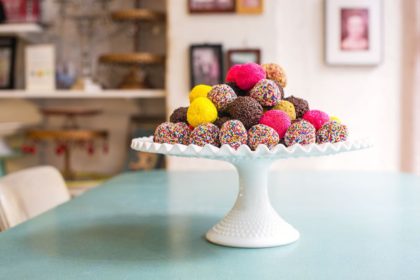 What does the future hold for Duane Park Patisserie?
What does the future hold for Duane Park Patisserie?
Well, eventually I’m going to have to stop. I don’t think about retiring because what am I going to retire to? I like this! My daughter is married and lives in California, and when they have a family, I may change my mind. But right now I’m really excited about Ring Ding Bar. As a standalone line, it could include expansion to the West Coast—who knows? But I have no immediate plans to stop. As long as I’m having a good time and it works financially, I’ll keep doing this. Neither of my kids is interested and I don’t blame them. They have their own lives. Anyway, I’m so lucky. When I get up in the morning, I still like going to work.
Photos by Claudine Williams, a contemporary portrait photographer based in Lower Manhattan. Her specialty is women’s portraiture as well as personal branding and magazine-style family photography.











